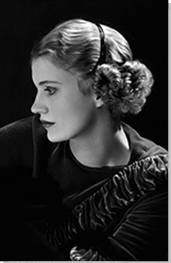Summary of Lee Miller
Lee Miller was a female American artist who refused to be defined by her gender, beauty or age. Not content to be limited in her personal life or artistic practice, she was a model and muse to several of the great Surrealists, a photographer, actor and one of the only female war correspondents to be credentialed during WWII. Miller was a fiercely independent and bohemian woman when society was still deeply restricted by traditional gender roles, and her life and work is a staggeringly varied, innovative, and extraordinary story.
Miller's artistic practice was grounded in the medium of photography, and her unique visual style documented the sights and landscapes she encountered on her travels around the world in a manner influenced by a Surrealist eye for the uncanny or strange. She also maintained a close relationship with many other artists, particularly those resident in pre-war Paris. She performed in films by Jean Cocteau, was painted by Picasso and was muse to Man Ray during their time living together. After her experiences as a war correspondent she retired to her farm in Sussex (England) and was largely unremembered as an artist until after her death, when her son Antony Penrose rediscovered her archive. Through his establishment of the Lee Miller Archive she then began to be acknowledged as an important artist in relation to both the Surrealist movement and the development of photography as an art form.
Accomplishments
- Millers photographic style combines techniques and formal qualities of Surrealism, such as the recontextualisation of the everyday, carefully manipulated framing to force new perspectives, and the unusual juxtaposition of objects and concepts. Her portrait of the Great Pyramid at Giza (Egypt), for example, is taken from the summit and consists only of its huge triangular shadow across the town below. It is undoubtedly a landscape dominated by the pyramid, but we do not see it - a decidedly surreal prospect.
- This Surrealist-influenced and irreverent photographic style, particularly as it began to be deployed by Miller in her coverage of the Blitz in London, had a lasting impact on the world of fashion photography. Miller's work that appeared in British Vogue during the war often included models wearing finery amongst the destruction and dilapidation caused by bombing, a juxtaposition that has now become a familiar high-fashion trope. The commonplace image of beautiful models wearing high fashion in ruins, junkyards or against other incongruous backdrops derives significantly from Miller's pioneering work.
- Miller's life and work are almost inseparable - like many Surrealists her mode of living was as much a rejection of convention as her artistic work. Miller's bohemian circle, particularly in Paris, was hedonistic and free in its attitudes to money, sex, marriage and respectability. This was doubly significant for the women who were part of the group, for whom this rejection of conventional society was made even more complete by the rigid expectations of their gender. Miller's life revolved around her artistic practice, and her artistic practice documented and reflected her extraordinary life in great detail.
- The ease with which Miller's own artistic practice was forgotten until its rediscovery by her son raises questions about pervasive narratives of (male) genius, and the minimization of female contributions to the development of key artistic movements like Surrealism. Miller was both muse and artist in her own right, yet was largely overlooked in favor of her male mentors and collaborators. Her collaborations with Man Ray were often credited to him alone, for example, and their eventual break stemmed from Ray's jealousies of Lee's work, but more particularly, her relationships.
Important Art by Lee Miller
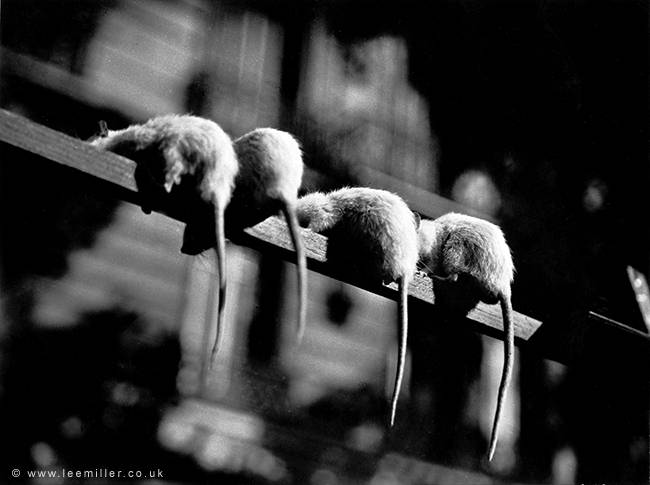
Untitled (Rat Tails)
Ordinary things, framed to detach them from context to dreamlike or humorous effect recur in Miller's early photographs of Paris. Here, four white rats perch side-by-side in an ambiguous space. Their little white rumps are brightly illuminated, and leafy shadows dapple the vague space around them. The rats were most likely living in a market stand amongst other domestic animals for sale, but their positioning, dramatic lighting and close cropping give the scene a fairytale ambiance.
French photographer and noted flâneur Eugene Atget won the admiration of the Surrealists for his idiosyncratic, atmospheric views of Paris, and his influence can be discerned in Miller's early street photography. Untitled (Rat Tails) shows technique inspired by Atget's work - lighting that creates atmosphere rather than detail, cropping that eliminates any sense of context - to create a mysterious, intriguing image from a common scene. In addition to an eye for the uncanny, Miller also displays a talent for grasping what Henri Cartier-Bresson later defined as the "decisive moment", foreshadowing her later success as a photojournalist.
Gelatin silver print - Lee Miller Archives
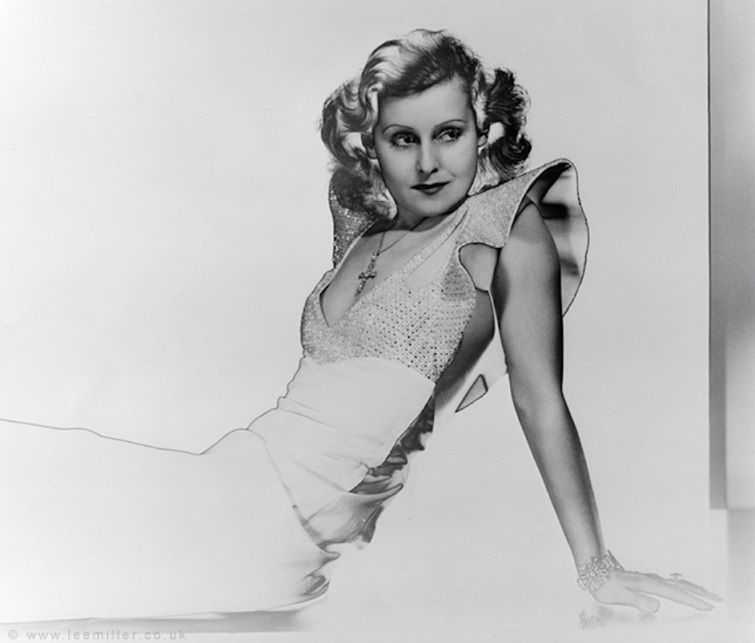
Lilian Harvey, Solarized Portrait
Anglo-German film star Lilian Harvey posed in Miller's New York studio. Elegantly attired in a sequined, satin evening gown, the actress is seated with her (cropped) legs outstretched, leaning on her left arm. Her gaze is directed over the supporting shoulder. However, this conventionally glamorous pose is made strange by the process of solarization. By deliberately over-exposing the film during development the resulting images are partially negative, with blacks and whites reversed.
The materiality of the figure is completely out of balance: her supporting hand fades in to a fog, while the definition between the ruffled sleeve of her dress and the background space is clearly defined with a black outline. Stark contrasts in her hair create a topographical surface, while her outstretched lower body is completely flattened, appearing almost graphic. This treatment of the figure recalls her son's statement that as a fashion model, "Lee was used to people looking at her as a thing rather than as a person". The technique of solarization here visualizes that feeling, breaking down the coherence of the whole figure and dissolving the barrier between model and surrounding space. Aside from the technique apparent here, the confident gaze and slight smirk of the subject illustrate Miller's definition of a good portrait: Catching the subject "not when he is aware but when he is his most natural self" was her goal. Like the best of Miller's work, this seemingly straightforward portrait turns something simple on its head, infusing a glamour shot of an actress in a pretty dress with a disorienting blur of unreality.
Gelatin silver print - Lee Miller Archive
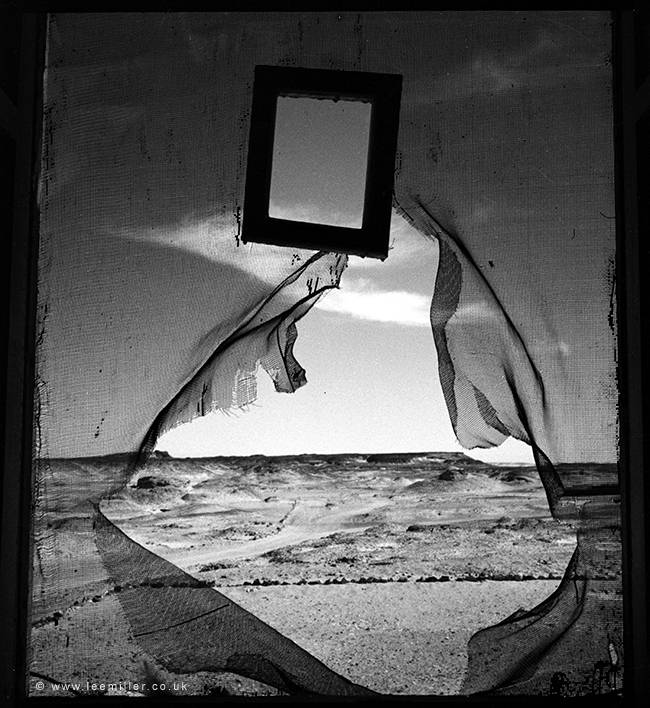
Portrait of Space
Taken from inside a tent near Siwa, Egypt, Portrait of Space looks out onto a desert landscape, through a torn mosquito net "window." A dark wood picture frame in portrait orientation hangs from the net above the tear. The landscape outside the window begins with a flattened, manicured foreground, surrounded with a border of stone. Beyond, a natural desert scape stretches to the horizon, marked by a discursive path, stones, and small hills. The sky above, occupying about 2/3 of the image, is punctuated with a few wispy, elongated clouds.
Miller's Egypt photos, this example in particular, embody the Surrealist impulses Miller developed early in her career while working with Man Ray in Paris in the late 1920s. The ideas associated with the movement, though, appear in Miller's work in subtle ways. Here a play on ambiguity and the permeability of boundaries are the most prominent. The title itself sets up an intellectual exercise. This "portrait" lacks the conventionally required subject and provides multiple "frames" - the dark frame around the whole image, the net, the tear in the net, the actual small frame dangling at the top and the stone border around the campsite. This sets up the viewer to determine what space is the subject of this subject-less portrait. Portrait of Space can be viewed as a "mise en abyme" or an image-within-an-image, "in which notions of inside and outside, are endlessly placed and displaced", as described by Patricia Allmer. Like her dematerializing portraits, Portrait of Space confronts and challenges the viewer with its details, made possible by the artist's unique vision and honed sense for presenting a slice of dislocated reality.
Lee Miller Archives
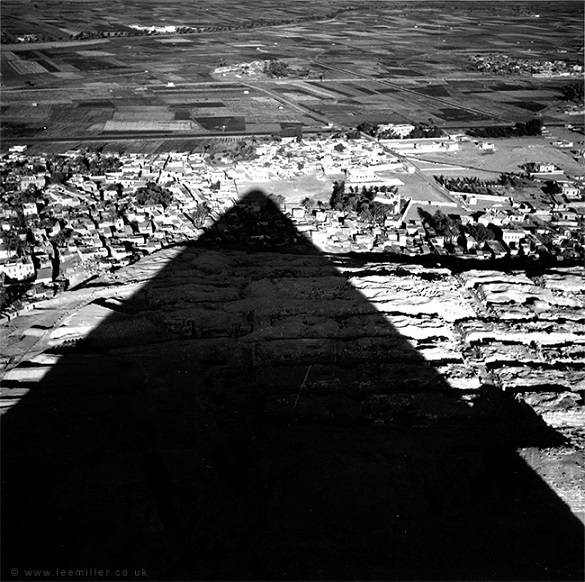
From the top of the Great Pyramid
This image, taken by Miller whilst living in Egypt with her first husband, shows the huge triangular shadow of the Great Pyramid at Giza on the village of Nazlet El-Samman below. It is an inversion of the classic touristic image of the pyramid, where the focus would be the monumental structure against the open sky to emphasize its size and imposition on the horizon. Miller's image, by contrast, places the viewer looking down on the everyday lives of Egyptians, living and working in the shadow of history. The focus on an unusual detail and its idiosyncratic perspective reveals Miller's debt to other Surrealist photography that isolates or foregrounds a particular close detail for effect (in this case the immense shadow).
Miller's inversion of perspective raises questions about the weight of history and its looming presence on the everyday, and perhaps also of colonial narratives. Egypt was under British control at the time of Miller's residence, and the picture could be read as an attempt to look beyond the internationally recognized symbols of a country to the realities of life for the majority of its citizens. Miller never really felt at home in Egypt as an American and bohemian free spirit in a conservative Arab country, and the image echoes both her remoteness as an observer and the distance between the Egypt of myth and reality.
Lee Miller Archives
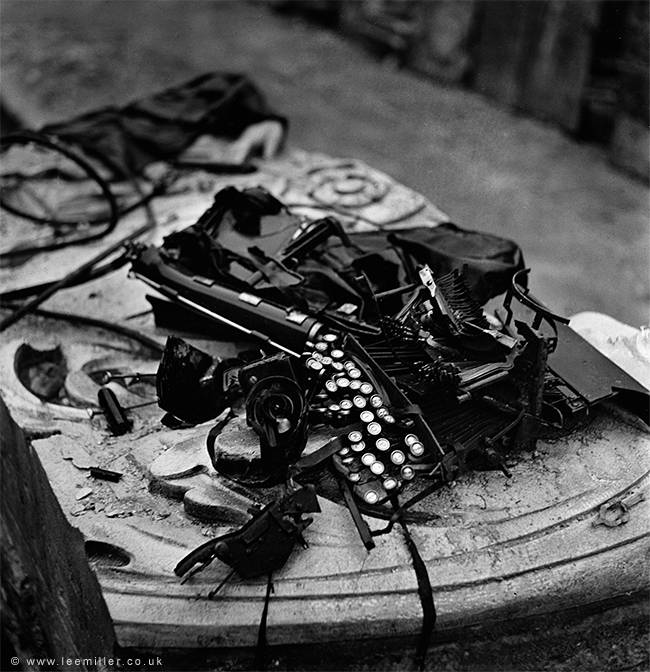
Remington Silent
A crushed typewriter sits on a carved architectural detail. Its keys form a tangled cascade with the ribbon, which then streams over the edge of the carved stone block. The focus fades quickly away from the viewer, but other sorrowful-looking detritus lies on the same stone behind the shattered typewriter. The in-focus objects are out of place - the bit of a building should not be horizontal on the ground. The mangled typewriter is rendered useless.
Among Miller's photographs of the London Blitz of 1940, published the following year in a book entitled Grim Glory: Pictures of Britain Under Fire, this image refers back to her Surrealist compositions in Paris. Unlike the deliberately context-free images of the 1930s, Remington Silent is visually ambiguous but contextually specific. Edward R. Murrow's introduction to Grim Glory states that "this little book offers you a glimpse of their battle. Somehow they are able to fight down their fears each night; to go to work each morning". Miller's photo encompasses the contrast between the terror of destruction and the necessity of living. The title has a whiff of humor as the Remington Silent was a popular typewriter model, although this particular typewriter has been rendered silent by the previous day's bombings. Despite this specificity, the composition's tight focus on one humble object, made unfamiliar and abstract in its destruction, displays Miller's ability to create dislocations within the everyday.
The effects of bombings created the odd juxtapositions that Surrealists labored to imagine. Cecil Beaton described this phenomenon as "the unfathomable laws of blast" that "scattered cherubs wings and stone roses...yet the lamp post [stands] erect with no pane of its lantern broken". Miller found easy inspiration in these baffling cityscapes. Anthony Penrose perhaps most clearly illuminated the uniqueness of her work in this period in The Legendary Lee Miller: "Lee's Surrealist eye was always present. Unexpectedly, among the reportage, the mud, the bullets, we find photographs where the unreality of war assumes an almost lyrical beauty. On reflection I realise that the only meaningful training of a war correspondent is to first be a Surrealist - then nothing in life is too unusual."
Gelatin silver print - Lee Miller Archives
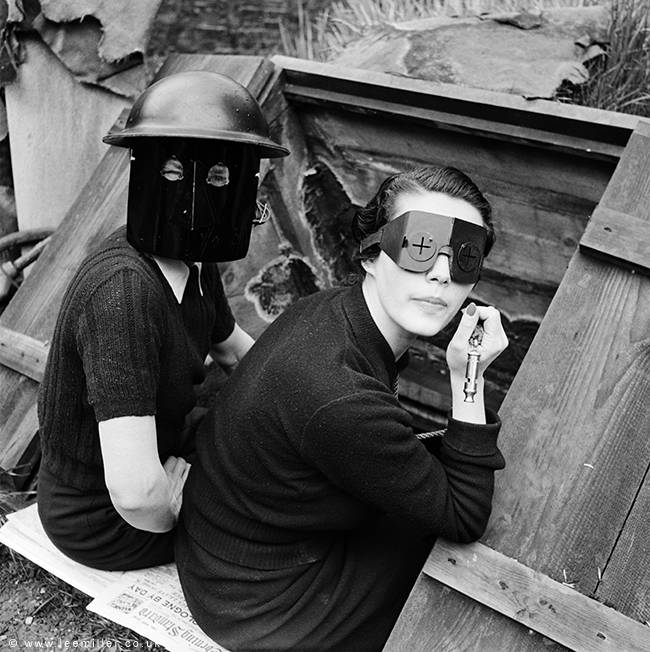
Firemasks, Downshire Hill
Taken while on assignment for Vogue magazine, this photo bridges Miller's work as a fashion photographer and as a war correspondent. Two models, wearing Air Raid Precautions masks sit casually on newspapers at the entrance to Miller's bomb shelter at her home in North London. The woman closest to the camera dangles a warden's whistle in her manicured fingers, held next to her face like a piece of jewelry in an advertisement. Behind her, a woman with her face fully covered appears to be grinning behind her protective mask, her crinkled eyes the only visible part of her face.
Miller's playfully dark sense of humor is evident in this image, as well as her consistent interrogation of a woman's place in the world, and the permeability of boundaries. Placing glamorous women who are customarily depicted in flawlessly aspirational settings on the ground, their faces covered with metal, reflects the dangerous days of the Blitz in London, but her approach also retains an element of fish-out-of-water humor. The truth of Miller's assertion in a 1932 interview with the New York Evening Post that it is the "personality of the photographer, his approach that is really more important than his technical genius", comes through in this image. Firemasks has an element of propaganda to it, as well. During the period, Vogue and other media outlets were obligated, according to the British Ministry of Information, to influence readers' wartime behavior. Images such as this showed women adapting to war, however cheekily, and carrying on as normal.
Gelatin Silver Print - Lee Miller Archives
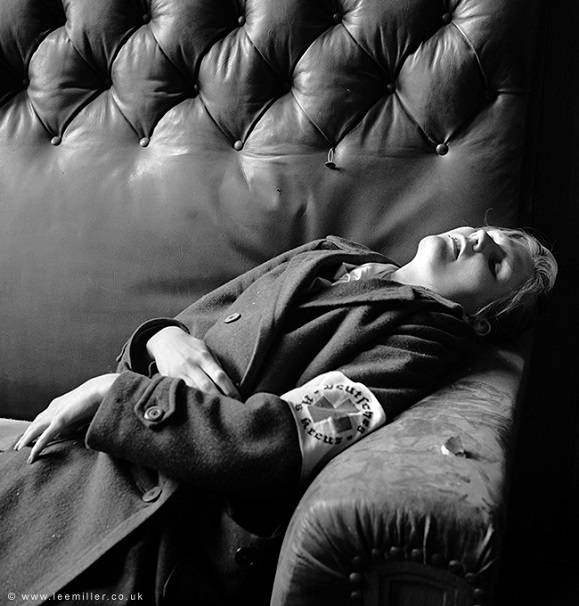
The Burgermeister's Daughter in Town Hall
As a member of the London War Correspondents Corps, Miller joined the Allied forces during the liberation of Western Europe in 1944. She travelled to Germany in 1945 and captured this image of the suicides of the city's Nazi vice-mayor and his family in Leipzig. The closely cropped view, showing only the daughter and wife of the official, removes extraneous detail and focuses on the individuals. The women, dead for some time, lie slumped on the formal office furniture. A map lies on the ground next to the daughter, who chose to die in her starched nurse's uniform.
Vogue published the photo, and Miller's accompanying article described how the high officials "gave a great party, toasted death and Hitler and poisoned themselves". The article also remarks upon the daughter's "extraordinarily pretty teeth," and her "nurse's uniform... sprinkled with plaster from the battle for the city hall which raged outside after their deaths". While other examples of Miller's wartime photos - particularly those from Buchwald and other concentration camps - are more brutal, The Burgermeister's Daughter particularly shows her consistent and unique interrogation the role of women as perpetrators in Nazi Germany. Miller, in her uniquely provocative and unvarnished manner, questions if anyone, even a teenaged nurse with nice teeth, can be an innocent bystander in times of war. Aesthetically, this photograph and its accompanying text affirm Becky Conekin's description of how her work "broke down barriers between fashion and war reportage. Her wartime pieces overflow with rich descriptions of her sensual impressions of the scenes of war around her-sounds, smells, and especially sights. Those scenes, as well as details of clothing, bodies, and hair, were frequently described in terms of high art".
Gelatin silver print - Lee Miller Archives
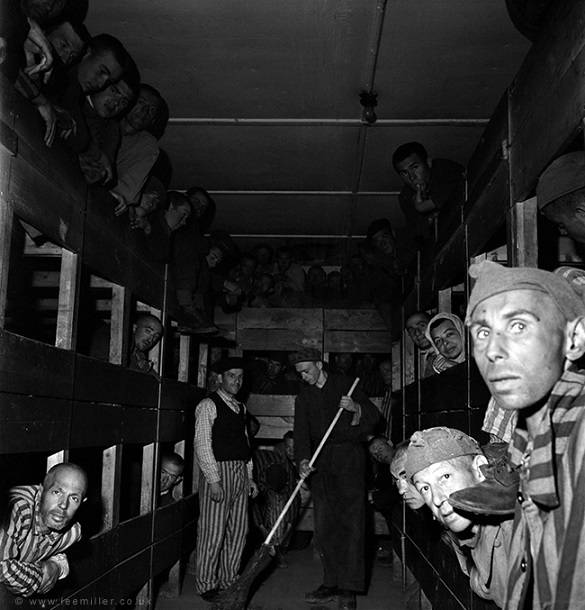
Liberated Prisoners in Their Bunks
This image, taken at Dachau Concentration Camp in 1945 shortly after its liberation by the American 6th Army, shows several prisoners peering at the camera from their bunks whilst another sweeps the central aisle. It is an image that offers a poignant emotional connection with prisoners who have been treated as less than human by their captors, with their eyes the focal point of the image. Miller's images from the Nazi concentration camps like this one still show hallmarks of her visual style, including multiple layers of focus and a close attention to textural detail.
Miller arrived in Dachau very soon after its liberation with LIFE photographer Dave Scherman, and like many of the correspondents could not believe the scale of the carnage and travesty of what they saw at the camps. Miller also reported the disbelief that greeted the sight from the soldiers, some of whom even went as far as to suggest this was an elaborate propaganda stunt by their own side. Miller later cabled her editor with the message 'I IMPLORE YOU TO BELIEVE THAT THIS IS TRUE'. During her time at the camp Miller, as an attractive woman in combat uniform, fascinated the prisoners and she was invited into their bunk houses for the purposes of documenting their squalor. Miller also photographed guards who had attempted to escape the camp and been were in turn attacked by the tortured and brutalized prisoners.
Lee Miller Archives
Biography of Lee Miller
Childhood
Elizabeth "Lee" Miller was born in Poughkeepsie, New York. She was the middle child of Florence and Theodore Miller, a mechanical engineer and avid amateur photographer. Theodore introduced his daughter to the craft of photography, teaching her the basics using his Kodak Brownie camera. Theodore also took regular portraits of Miller throughout her early life. Along with taking photographs, she and her brothers enjoyed tinkering with machines to learn how things worked, and she had a mostly pleasant and privileged childhood in an upper-middle-class and progressive household. Her youth was marred, however, when she was raped by the guest of a family friend when she was seven. Scholars have frequently viewed her later photography through a lens tinted by this early trauma.
Early Training and Work
Described as "an idle student and an active rebel", as a teenager Lee was expelled from several private schools in Poughkeepsie. An interest in theater led to her attendance at École Medgyes pour la Technique du Theatre in Paris for seven months, where she studied lighting and set design. In an interview many years later she said of this first sojourn abroad, "One look at Paris and I said, 'This is mine - this is my home'".
Miller returned to New York though, going on to participate in the Experimental Theater at Vassar College in her hometown - which she had begun unflatteringly referring to as "Pokey". Here she found that theater was not the right medium for her ambition. In one of her notebooks she wrote that she felt "Void-yet full of yearning," and that her "fingers feel empty with longing to create." In 1926, at age 19, she enrolled at the Art Students' League in New York to study life drawing and painting.
That year, she literally stumbled in to her professional modelling career when the major magazine publisher Condé Montrose Nast prevented her from stepping into oncoming traffic. Impressed by her beauty, he hired her to model for Vogue, where Miller posed for notable fashion photographers Arnold Genthe, Nikolas Muray, and Edward Steichen. For Steichen, it was said, "Lee was the ideal model for the mid-twenties mode. She was tall, carried herself well, and her strong profile and fine blonde hair exactly suited his clear, elegant style." Steichen also encouraged her to take up photography seriously, and provided her with a letter of introduction to Surrealist photographer Man Ray.
In 1929, Miller left New York for Paris to seek out Ray. She arrived "fed up to the teeth with painting. All the paintings had been painted as far as I was concerned and I became a photographer". According to Miller's later account, she'd tracked Man Ray down at a Paris nightclub, and announced to him "My name is Lee Miller and I'm your new student. He said he didn't take students, and anyway he was leaving Paris for his holiday. I said, I know, I'm going with you - and I did. We lived together for three years". Whether this beginning is embellished or accurate, she became his model and collaborator, as well as romantic partner. During this time, by accidentally turning on a light while working with Man Ray in his darkroom developing film, Miller's discovered the technique of solarization, which Man Ray would begin to use as a deliberate formal technique in his photography.
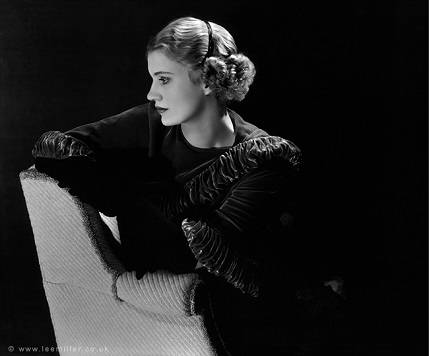
While in Paris, Miller also worked with French Vogue, on both sides of the camera. She assisted famed fashion photographer George Hoyningen-Huene, working alongside his protégé Horst P. Horst. She recalled that she and Horst "worked like galley slaves", both of them modelling as well as undertaking whatever tasks the magazine required. Though she learned a great deal about photography from Heune, she owes more to Man Ray for her developing style, adopting Ray's use of smaller cameras and relying on cropping to reveal the composition.
Miller's role as muse and model was an important part of her youthful Paris experience. Man Ray photographed Miller, or parts of Miller, on numerous occasions. Their relationship introduced her to a circle of like-minded artists and art world contacts that would remain in her life over many years. She appeared in several film projects, most notably Jean Cocteau's The Blood of a Poet (1930), in the role of a classical statue. Fellow surrealist Eileen Agar said Miller was "a remarkable woman, completely unsentimental and sometimes ruthless". Her ambition and drive to produce her own work - as well as her relationships with other men, including an affair with Aziz Eloui Bey (whom she later married) - eventually led to her break with Ray and depart from Paris.
Later Career
Miller returned to New York in 1932, setting up a photography studio with her brother Erik. Her Surrealist influences surface in the studio's specialty of celebrity portraits. She also did advertising work, and continued to model and photograph for Vogue.
In 1934, Miller married Bey, and moved with him to Cairo in his native Egypt. She turned her eye to the desert landscape and the country's iconic ruins and architecture, creating some of her most complex and challenging photographs to date. Miller did not find life in Egypt particularly satisfying, though. Despite her photography and side projects that included snake charming lessons, she described her state of mind as "a water soaked jigsaw puzzle, drunken bits that don't match in shape or design", describing both her restless discontent and her gift for evocative language, later used to great effect in her photo essays.
In 1937 she travelled without her husband to Paris. This journey brought her back in to the Surrealist orbit, renewing her friendship with Man Ray, and introducing her to British artist and art collector Roland Penrose, who was also associated with the Surrealist movement and whom she would eventually marry. The rest of that summer, the group of artists - Penrose, Paul and Nusch Eluard, Max Ernst and Leonora Carrington, Ray and his partner Ady Fidelin - travelled around Europe, enjoying a stream of hedonistic retreats. Miller's biographer said "it would be hard to overstate the group's delight in playing at life rather than having to take it seriously, at a time when war seemed imminent". Though no doubt enjoyable, this period did little for the women's careers (although Miller's reputation as an artist's muse was further strengthened by posing for Picasso). Carrington later reflected that the Surrealist women artists functioned "like talking dogs - we adored the master and did tricks for him".
This sojourn marked the beginning of the end for Miller's first marriage. She left Bey in 1939 and moved to London with Penrose. The same group of artists reunited briefly before the war at Ernst and Carrington's French farmhouse for "perhaps the last Surrealist picnic" that July. Shortly after Miller and Penrose departed, Ernst was taken to a camp for aliens, ending the reality-defying idyll.
The move to London brought Miller back into the Vogue orbit, where she picked up her work as a fashion photographer. The outbreak of World War II led to her most widely-seen work as a photojournalist and war correspondent. Her photographs of the Blitz through 1941 were published in British Vogue and the book Grim Glory: Pictures of Britain Under Fire (1941). By the end of that year, though, Miller expressed frustration with her work during such perilous times. In a letter to her parents she mused, "It seems pretty silly to go on working for a frivolous paper like Vogue, tho [sic] it may be good for the country's morale it's hell on mine".
Miller became an accredited war correspondent in 1943, and joined the 83rd Infantry Division of the US Army the following year. Travelling with the 83rd, she photographed the siege of Saint-Malo, the liberation of Paris, and both Dachau and Buchenwald concentration camps. Anthony Penrose later described the disturbing contrast of the photographs and their context in Vogue: "The gore and violence of her articles feature boldly in the pages...the grim skeletal corpses of Buchenwald are separated by a few thicknesses of paper from delightful recipes to be prepared by women dressed in sumptuous gowns". The unsparing images she captured embodied the atrocities of the war, but also, at times, retained her darkly playful sensibilities. Her commitment to documenting what she witnessed can be surmised from the recollection of Ari Von Soest, a former inmate at Dachau who recalled the inmate's shock at seeing a women in uniform, and their gratitude for her interest in their stories, stating, "She was the only one of the liberators who stayed with us; she went to the prison hospital where prisoners were sprayed with DDT; she joined our celebrations".
After the War, Miller suffered from what now might be recognized as post-traumatic stress, drinking heavily and retreating into depression, both of which would recur throughout the rest of her life. She eventually returned to celebrity portraiture, but began winding down her practice as a professional photographer. She married Penrose in 1947, and they had a son, Anthony, that same year. Miller and Penrose frequently entertained art world luminaries at their home at Farleys House in Sussex, UK. Her final contribution to Vogue in July of 1953, entitled "Working Guests," featured some of their illustrious visitors laboring around the farm, including Alfred J. Barr, director of the Museum of Modern Art in New York, feeding her pigs and artist Max Ernst planting petunias.
Miller's time at Farleys House was occupied by cooking food from around the world, compiling a (never completed) cookbook, and supporting Penrose as he founded and developed the Institute of Contemporary Arts in London. Despite this activity however, Miller often appeared bored or frustrated. She continued to drink heavily, and there were successive arguments with both her husband, son, and the old friends who visited. Although continuing to travel, she refused to take photographs she continued to take photos of family and friends but not commissioned images, and any requests for access to her old work were denied we are not aware of requests it was more that she put them away and did not talk of her previous work. It was not until near the end of her life that she made peace with her son, after he returned to live on the farm with his wife and new baby. Miller died at home of cancer in 1977, in the arms of her husband. After her death her son - largely unaware of his mother's body of work - found thousands of prints and negatives in the attic of their home. He has since created the extensive Lee Miller Archives, enabling the rediscovery of Miller's impressive oeuvre in the 1980s.
The Legacy of Lee Miller
Miller's unconventional career trajectory hampered her historical reputation. Her early association with the Paris Surrealists - particularly her role as Man Ray's "perversely enchanting muse" - frequently overshadows her own artistic accomplishments. Her abandonment of photography, and the consignment of all her work to her own attic also limited her impact during her lifetime. Her association with fashion has also colored the interpretation of Miller's work. As her biographer Carolyn Burke states, "to this day, her life inspires features in the same glossy magazines for which she posed...this approach turns the real woman in to a screen onto which beholders project their fantasies", and further perpetuates the legend of Lee Miller as an "American free spirit wrapped in the body of a Greek goddess".
The rediscovery of her remaining prints and negatives provided an opportunity for reassessment of her work. Contemporary methodologies have focused on her unique personal vision and her innovative integration of avant-garde principles and photojournalism. Recent exhibitions of her photography include a travelling retrospective in 2008, and a 2015 exhibition of her World War II photography at London's Imperial War Museum. The force of her personality and biography remain central to interpreting her work. Miller has been recognized as among the most original and ambitious photographic artists of the 20th century, and a subtly transgressive artist, who - as Lynn Hilditch asserts in Lee Miller, Photography, Surrealism and the Second World War - took off from her Surrealist background and "pushed the boundaries both of art and war photography, often using unconventional methods to comment on such multifaceted issues as sex, gender, death, and war".
This blurring of boundaries between art photography and photojournalism eventually reshaped the latter. Her photos for Vogue of London during the Blitz, and the corresponding juxtaposition of commercialism and carnage prefigure later work like Martha Rosler's "Bringing the War Home: House Beautiful" series (1967-1972), which similarly contrasts consumer prosperity and scenes of war in Vietnam. This aesthetic of blighted urbanity placed against designer wares on beautiful models became so widely adopted that it has become standard fashion editorial fare. The confrontational style of her then-innovative, close-up images from 1945 of starving children in Vienna have also become commonplace in photography, the intimate perspective a shorthand for creating a connection between a viewer and the subject.
Influences and Connections

-
![Edward Steichen]() Edward Steichen
Edward Steichen - Theodore Miller
- George Hoyningen-Huene
-
![Man Ray]() Man Ray
Man Ray -
![Max Ernst]() Max Ernst
Max Ernst -
![Dorothea Tanning]() Dorothea Tanning
Dorothea Tanning -
![Jean Cocteau]() Jean Cocteau
Jean Cocteau - Paul Elouard
-
![Martha Rosler]() Martha Rosler
Martha Rosler - Holly Davey
- Michael Herz
- Graeme Fidler
Useful Resources on Lee Miller
- The Lives of Lee MillerOur PickBy Antony Penrose
- Lee Miller: A Life with Food, Friends and RecipesOur PickBy Ami Bouhassane
- Lee Miller: A LifeBy Carolyn Burke
 Ask The Art Story AI
Ask The Art Story AI